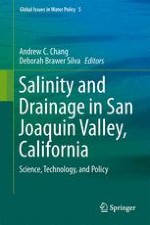2014 | OriginalPaper | Chapter
9. Management of Evaporation Basins To Reduce and Avoid Adverse Impacts to Waterbirds
Authors : Douglas E. Davis, Charles H. Hanson
Published in: Salinity and Drainage in San Joaquin Valley, California
Publisher: Springer Netherlands
Activate our intelligent search to find suitable subject content or patents.
Select sections of text to find matching patents with Artificial Intelligence. powered by
Select sections of text to find additional relevant content using AI-assisted search. powered by
